Want to protect more than one device with your VPN? Learning how to make a VPN hotspot lets you share your VPN connection with gadgets like game consoles, tablets, or other phones.
VPNs usually secure just one device, but with the right setup on Windows or Android, you can extend that protection to others via a hotspot. It’s perfect for public Wi-Fi, streaming, or devices that don’t support VPN apps.
This guide covers step-by-step methods for Windows, Android, USB tethering and explains what’s possible (and not) on iPhone.
You can make a VPN hotspot by connecting your Windows or Android device to a VPN, then sharing its internet via Wi-Fi or USB tethering. iPhones don’t support sharing VPN traffic through hotspots, but you can use a VPN on the receiving device or set up a VPN router instead.
Can You Share a VPN Over a Hotspot?
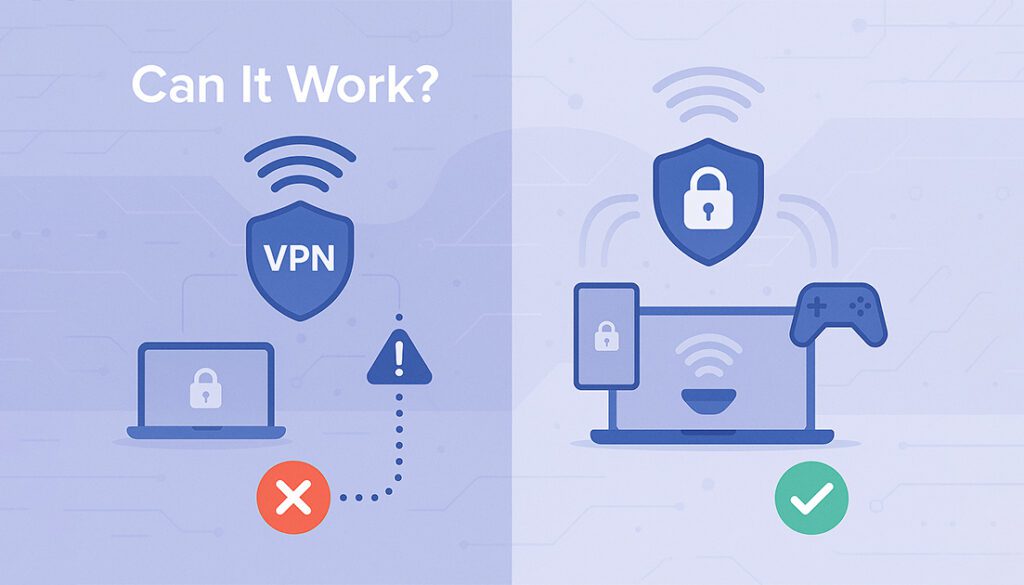
Sharing a VPN over a hotspot isn’t as straightforward as it sounds.
By default, most devices only route VPN protection to themselves, not to anything connected through a hotspot. So even if your phone or PC is using a VPN, other devices using that hotspot might be exposed.
❓ Why It Doesn’t Work Automatically
🔸 Shares internet, but skips VPN tunnel
🔸 No encryption for connected devices
🔸 Your real IP may still be exposed
✅ Can It Be Fixed?
Yes — with a proper setup, you can route your VPN through the hotspot and protect everything connected.
✔️ Adjusting adapter settings on Windows
✔️ Using tethering apps or root access on Android
✔️ Trying workarounds for USB sharing
🚫 What About iPhones?
iPhones currently do not allow VPN sharing via hotspot due to Apple’s restrictions. We’ll cover a workaround later in the guide.
How to Make VPN Hotspot on Windows

If you’re using a Windows laptop or desktop connected to a VPN, you can share that VPN-protected internet with other devices via a mobile hotspot.
It takes just a few setup steps, no extra tools needed.
🔧 Steps to Set Up VPN Hotspot on Windows:
Step-1: Enable Hotspot
- Go to Settings → Network & Internet → Mobile Hotspot
- Turn it ON and set your network name and password
Step-2: Connect VPN
- Launch your VPN app and connect to a server
- Confirm that your traffic is encrypted and secure
Step-3: Enable Internet Sharing
- Open Control Panel → Network and Sharing Center
- Click Change adapter settings
- Right-click your VPN connection → Properties → Sharing tab
- Check: “Allow other users to connect…”
- Select your new hotspot as the connection to share with
🧠 Tips
- Make sure the VPN protocol supports internet sharing (WireGuard may not work with all setups)
- Some antivirus software or firewalls may block sharing
- Restart your system after setup if it doesn’t work right away
How to Share VPN Connection on Android
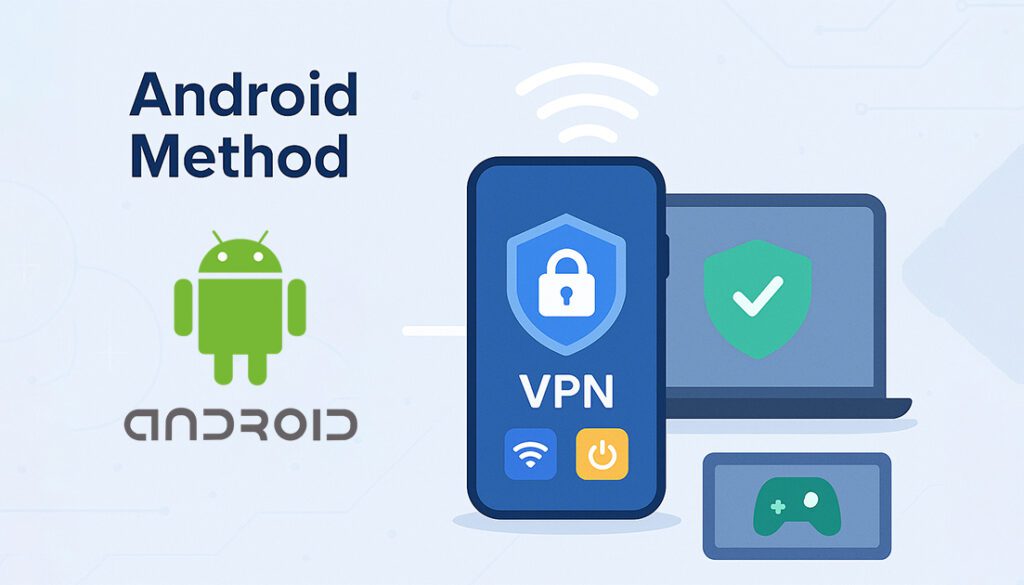
Sharing a VPN over a hotspot on Android is possible, but it depends on your device setup.
Android doesn’t route VPN traffic through the mobile hotspot by default. However, there are workarounds that let you share the connection securely.
Option 1: Non-Rooted Devices (Easier)
For most users with a regular Android device, you can use a third-party app like VPN Hotspot (by Mygod).
✔️ Install the VPN Hotspot app from Google Play
✔️ Connect to your VPN as usual
✔️ Launch VPN Hotspot → choose the interface to share
✔️ Enable hotspot mode and start tethering
No root is needed, but this app uses local VPN routing tricks, so some apps or games may not work perfectly.
Option 2: Rooted Devices (Advanced)
Rooting gives you full control over how your Android routes traffic, including VPN connections. If your device is rooted, you can use advanced apps or terminal commands to share Virtual Private Network-protected internet over hotspot.
 Method: Using ProxyDroid
Method: Using ProxyDroid
✔️ Download and install ProxyDroid from a trusted source or F-Droid
✔️ Connect your Android device to a VPN
✔️ Launch ProxyDroid and enter the proxy details from your VPN (localhost:port)
✔️ Select apps to proxy or enable full-device routing
✔️ Turn on hotspot and allow connected devices
This lets you force traffic through the VPN using proxy-level control. Some technical knowledge is required to configure this properly.
🔀 Alternative: Manually Redirect VPN Traffic via iptables
If you’re comfortable with terminal commands, you can redirect VPN traffic using iptables:
bashCopyEditiptables -t nat -A POSTROUTING -o tun0 -j MASQUERADE
iptables -A FORWARD -i tun0 -o wlan0 -m state --state RELATED,ESTABLISHED -j ACCEPT
iptables -A FORWARD -i wlan0 -o tun0 -j ACCEPT
Note: tun0 is typically your VPN interface and wlan0 is your hotspot. These may differ by device.
⚠️ Warning for Root Users
🔸 Void your device warranty
🔸 Break OTA updates
🔸 Lead to bootloops if done incorrectly
🧠 Keep in Mind
- Some VPNs may block hotspot sharing on mobile
- Data saving/battery modes can interfere with tethering
- Android versions 10+ handle routing differently, results may vary
For more detailed Guide: Sharing VPN connection over hotspot on Android
Share VPN via USB Tethering
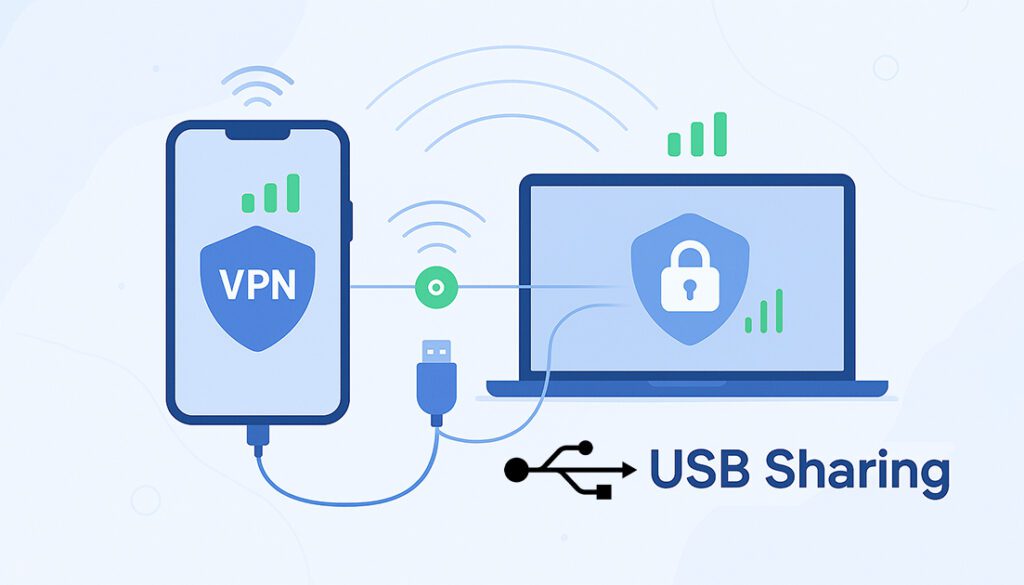
If setting up a Wi-Fi hotspot isn’t working or you’re using a device that doesn’t allow VPN sharing wirelessly, USB tethering is a great alternative.
This method lets you connect your VPN-protected Android phone to a computer or another device using a USB cable. It’s especially helpful when Wi-Fi isn’t available or stable.
🔍 How It Works
Your phone connects to a VPN, then shares that encrypted internet connection with another device through USB. It’s fast, stable, and doesn’t need root in most cases.
⚙️ Requirements
✔️ VPN app installed and connected
✔️ USB debugging enabled (in developer options)
✔️ Tethering option enabled under Settings → Network → Hotspot & Tethering
✔️ Compatible OS on the receiving device (Windows/macOS)
🔧 Steps to Set Up
1. Connect your Android phone to the other device via USB
2. Enable VPN on your phone
3. Go to Settings → Network & Internet → Hotspot & Tethering
4. Toggle ON USB tethering
5. The receiving device should now get internet routed through the VPN
🧠 Keep in Mind
- This method shares the VPN without broadcasting a Wi-Fi signal
- Battery drain is minimal compared to wireless sharing
- Speed is generally stable, but limited by USB 2.0/3.0 ports
How to Share VPN from macOS
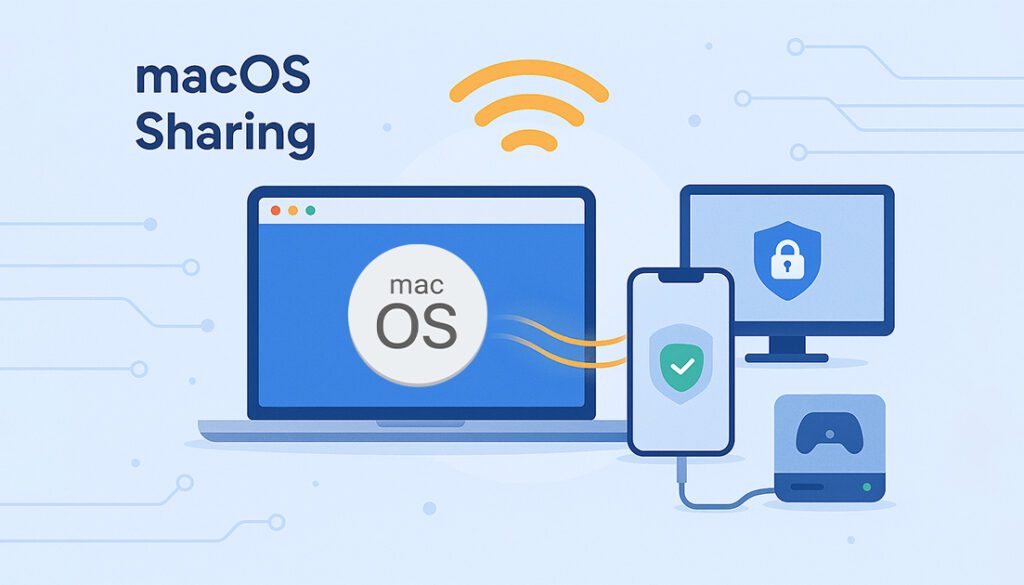
If you’re using a MacBook or iMac, you can share your VPN connection with other devices, but you’ll need to configure it manually.
This can be done through Wi-Fi, Ethernet, or Bluetooth, depending on your setup.
⚙️ What You’ll Need
✔️ A stable internet connection
✔️ Admin privileges to adjust network settings
✔️ Optional: USB-to-Ethernet adapter if using wired sharing
🔧 Steps to Share VPN from Mac via Wi-Fi
2. Go to System Settings → Sharing
3. Enable Internet Sharing
4. Share the VPN-connected interface (e.g., Ethernet) to Wi-Fi
5. Turn on the hotspot, your Mac will now broadcast a VPN-protected network
- Connect your Mac to the VPN
- Go to System Settings → Sharing
- Enable Internet Sharing
- Share the VPN-connected interface (e.g., Ethernet) to Wi-Fi
- Turn on the hotspot, your Mac will now broadcast a VPN-protected network
⚠️ Important Notes
🔸 Some VPN apps (like ExpressVPN) don’t support internet sharing from the app tunnel
iPhone Users: Can You Share VPN Hotspot on iOS?
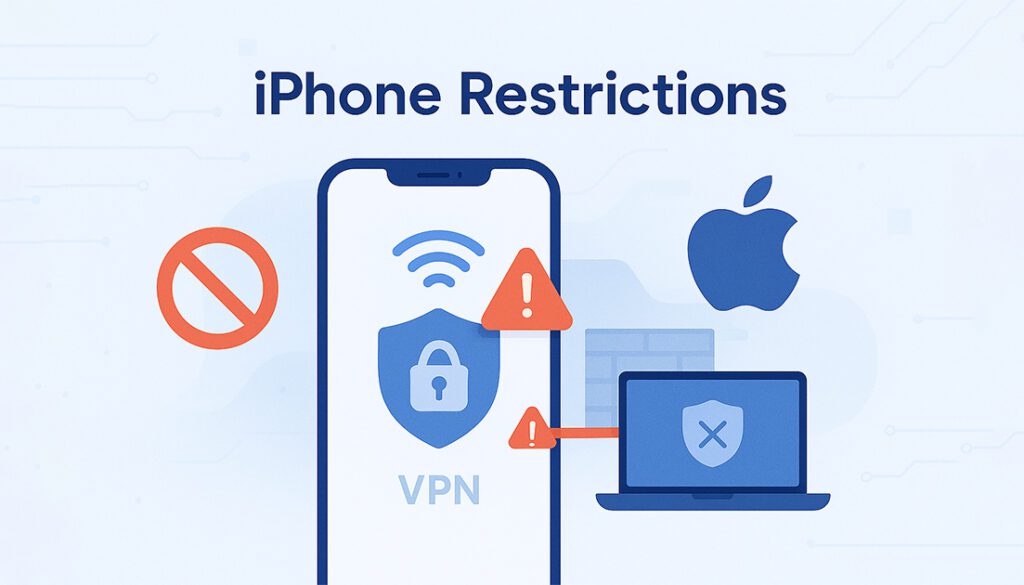
If you’re using an iPhone or iPad, the short answer is: you can’t share your VPN connection over a hotspot.
That’s not a bug, it’s how iOS is designed.
🚫 Why It Doesn’t Work on iPhone
⚠️ Summary of iOS Limitations
⚠️ iOS does not allow VPN routing through mobile hotspot
⚠️ No third-party app can override this (unless jailbroken)
⚠️ VPN only protects the iPhone itself, not connected devices
✅ Workarounds for Apple Users
✔️ Set up a VPN-compatible router at home (if it supports VPN apps)
✔️ Or use a Windows/Android device to share VPN instead
Comparison: VPN Hotspot vs USB vs Router Setup
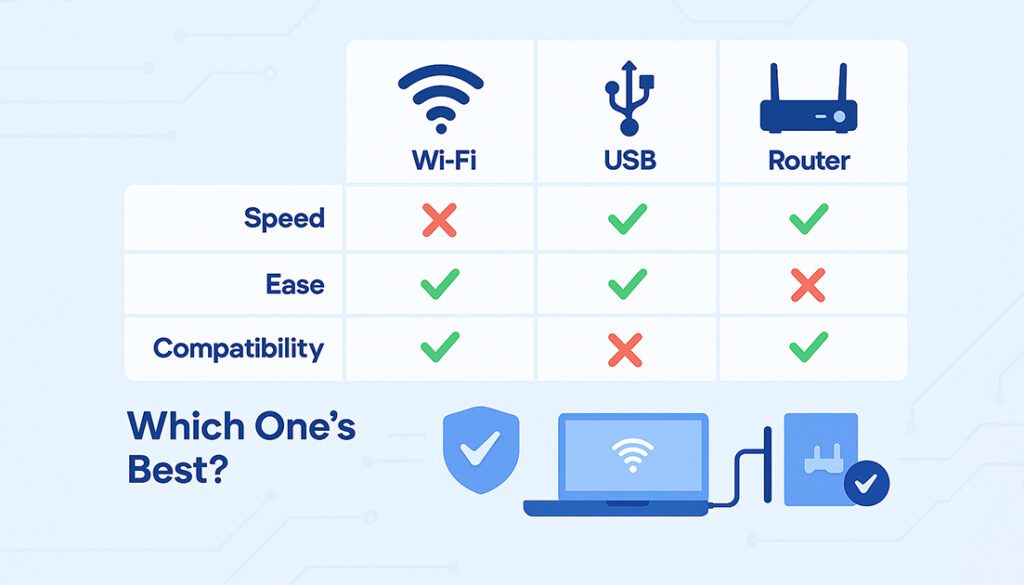
When it comes to sharing your VPN connection, each method has its pros and cons.
Use the table below to compare the options side by side:
| Feature | Wi-Fi Hotspot | USB Tethering | VPN Router |
|---|---|---|---|
| Speed | ⚠️ Medium (depends on Wi-Fi & system load) | ✅ Fast & stable | ✅ Consistently high (wired or mesh) |
| Ease of Setup | ✅ Moderate (few steps) | ✅ Easy (if USB supported) | ❌ Advanced (router config needed) |
| Device Compatibility | ✅ Phones, tablets, smart TVs | ⚠️ Computers only | ✅ All devices (including consoles) |
| Works Without Root | ⚠️ On Android, may need apps | ✅ Yes | ✅ Yes |
| Best For | Quick sharing, mobile use | One-to-one sharing, stable link | Home networks, permanent setups |
Troubleshooting: When VPN Doesn’t Work Over Hotspot
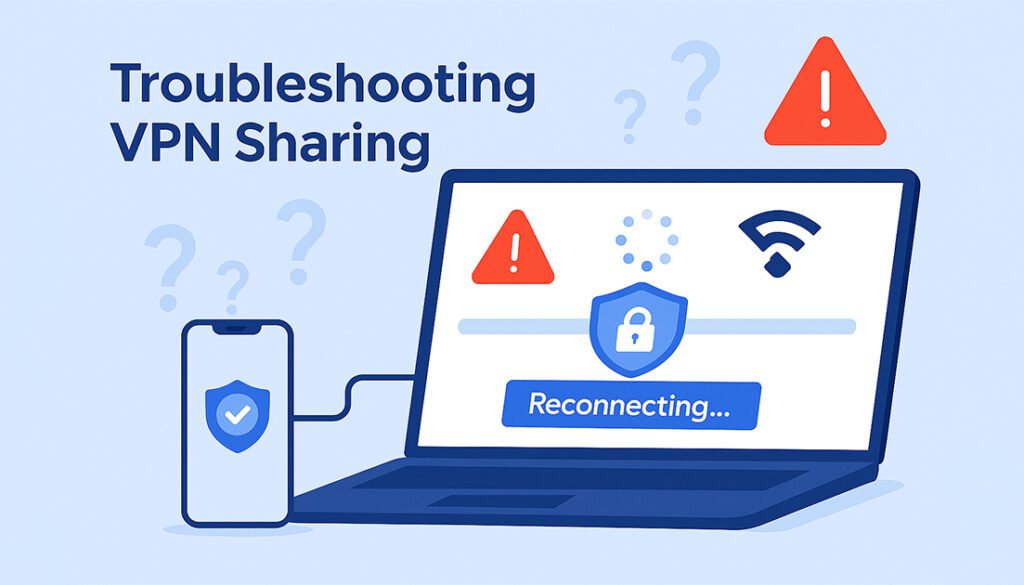
Sometimes, even after setting things up correctly, your devices might still not connect through the VPN.
Here are common issues and how to fix them.
🛑 Common Problems
🔸 VPN connection may drop after hotspot is enabled — reconnect it after hotspot is active
🔸 DNS leaks or IP leaks can occur — test your connection using dnsleaktest.com
🔸 Your firewall or antivirus may block internet sharing — try disabling temporarily
🔸 Some VPN protocols (like WireGuard) may not allow sharing — switch to OpenVPN or IKEv2
🔸 Ensure the VPN tunnel is the interface being shared — not your regular Wi-Fi or Ethernet
⭐ Bonus Tip
If you’re still stuck, check out this short video from Surfshark on improving VPN speed and stability. It also covers connection drops, slow speeds, and protocol tweaks.
Bonus: Use a VPN-Compatible Router Instead
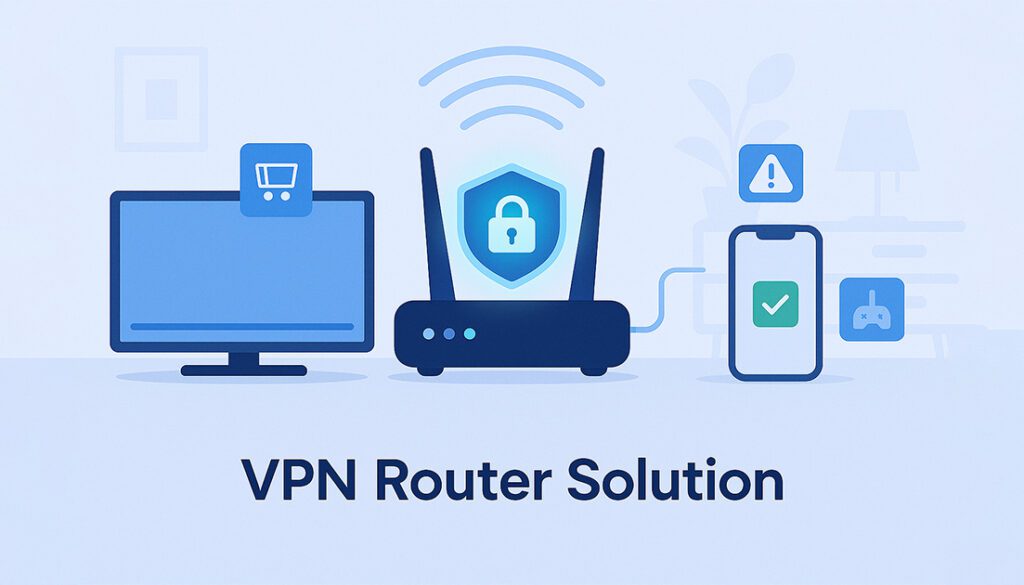
If you’re frequently sharing your VPN connection or want a hands-off setup for multiple devices, a VPN-compatible router is your best bet.
It protects your entire home or office network without needing to share connections manually.
🔍 How It Works
You install a VPN directly on the router, so every device that connects to it, phones, TVs, laptops and consoles gets VPN protection automatically.
This includes devices that don’t support VPN apps on their own.
⚙️ What You’ll Need
✔️ A VPN provider with router configuration files
✔️ Basic knowledge of accessing your router dashboard
✔️ Optional: Flashing firmware (e.g., DD-WRT, OpenWRT) for advanced features
FAQs
Can you share VPN over mobile hotspot?
Yes, but only on certain devices. Android and Windows can share VPN connections using hotspot or USB tethering with proper setup. iPhones cannot share VPN traffic via hotspot.
Why doesn’t VPN work when using hotspot?
Most operating systems don’t route VPN traffic through the hotspot interface by default. You’ll need to manually configure adapter sharing or use specific apps to make it work.
Does VPN protect devices connected to my hotspot?
Only if the VPN connection is correctly shared through the hotspot. Without proper setup, your devices may still be exposed.
Can I share VPN from iPhone to other devices?
No. Apple’s iOS doesn’t allow VPN traffic to be routed through hotspot. You’ll need to use VPN on the receiving device or use a VPN router instead.
What’s the best way to share VPN with multiple devices?
Using a VPN-compatible router is the most stable and secure option. It encrypts all traffic from every connected device without needing to configure them individually.
Is USB tethering with VPN safer than a hotspot?
Yes. USB tethering offers a more stable and direct connection. It’s also less likely to leak traffic compared to wireless hotspots.
Do I need to root my phone to share VPN?
Not always. Many users can share VPN using apps like VPN Hotspot (Android) without root. But full control and advanced setups like iptables do require root access.
Final Verdict:
Learning how to make a VPN hotspot opens the door to protecting more than just your main device.
Whether you’re using Windows, Android, USB tethering, or a full VPN router setup, each method has its place.
For stability, USB tethering is great.
And for always-on protection across every device, nothing beats a VPN router.
Choose the method that fits your situation and keep your entire network secure.
🔹 You can share your VPN connection through a hotspot using Windows, Android, or USB tethering.
🔹 iPhones cannot share VPN via hotspot due to iOS restrictions.
🔹 macOS allows sharing if VPN is set up at the system level.
🔹 USB tethering is more stable than Wi-Fi hotspot.
🔹 For the best experience, consider setting up a VPN-compatible router for full-network protection.
Want a VPN That Works Perfectly with Hotspot Sharing?
Not all VPNs support hotspot or tethering features. We’ve tested the most compatible ones for hotspot sharing, speed, and multi-device use.
View Top VPNs
 Method: Using ProxyDroid
Method: Using ProxyDroid
